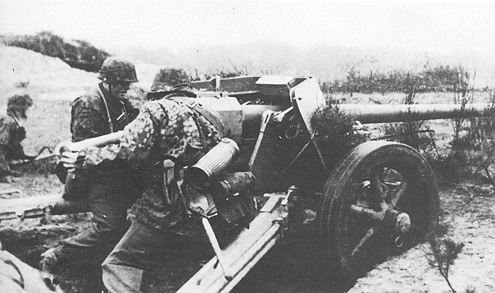Panzerjager
German Artillery
|
Panzerjager [ Mike Kaspar ] Just as every German tank was a Tiger for many Allied
soldiers so every anti-tank gun was an 'Eighty Eight'.One
of the great artillery weapons of all time the 8.8-cm anti-aircraft gun was
certainly a tank killer of note.But it was not the
only such weapon in the Wehrmacht's armory,not even the most numerous. |
|
|
| Emplacement
of a 75mm Pak 40 in the Carpathian foothills (May 30 , 1944) .The
heavily armored Soviet T-34 and KV-1 tanks gave a new urgency to
anti-tank gun design and two new 7.5cm guns were developed , the
PaK 40 being manufactured by Rheinmetall-Borsig
and the PaK 41 produced by Krupp
entered service.Both were fairly powerful
, though the PaK 40 was effectively scaled
up version of the PaK 38 |
|
Pak 40 75mm Anti-Tank Gun |
|||
|
Shell |
Weight |
Muzzle Velocity |
Penetration |
|
Anti-tank |
6.8 kg |
792 meters/sec |
132mm at 500 meters |
|
Hard-core |
3.2 kg |
930 meters/sec |
154mm at 500 meters |

|
The new gun was an enlarged version of the earlier 50mm
Pak.The muzzle brake , the double shield and the torsion-bar suspension
were retained.The mount still had tubular spars but now they were
made of steel instead of aluminum.The ballistic performance could
thus be increased.The newly introduced Anti-tank shell 40 weighed
6.8 kg and achieved a penetrating power of 132mm of armour at a
500 meter range with a muzzle velocity of 792 meters per second.The
hard-core shell that was also introduced at the time weighed 3.2
kg but with a muzzle velocity of 930 meters per second and could
penetrate up to 154mm of armour at 500 meters.These shells had to
be replaced later on account of a serious shortage of tungsten.A
2.7 kg shell with a core diameter of 60mm was not introduced , but
a hollow shell only achieved a short range because of its lower
muzzle velocity of 450 meters per second. |
